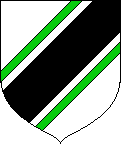Cotised: Difference between revisions
From Cunnan
Jump to navigationJump to search
No edit summary |
m (Reverted edits by 121.241.160.19 (Talk); changed back to last version by Cian) |
||
| (2 intermediate revisions by 2 users not shown) | |||
| Line 1: | Line 1: | ||
[[Image:Bendsinistercotised.PNG|right]] |
[[Image:Bendsinistercotised.PNG|right]] |
||
In [[heraldry]], an [[ordinary]] which is '''cotised''' has a narrow line, or cotise, running |
In [[heraldry]], an [[ordinary]] which is '''cotised''' has a narrow line, or cotise, running parallel to its edges. Cotising an ordinary is considered as adding a [[secondary charge]]. The cotise is typically depicted as 1/4 of the width of the ordinary. |
||
The cotises for some ordinaries have special names. The cotises of a [[pale]] are called ''endorses'', and so instead of being [[blazon]]ed ''a pale cotised'', it is instead ''a pale endorsed''. The cotises for a [[chevron]] can also be called ''couple-closes''. |
The cotises for some ordinaries have special names. The cotises of a [[pale]] are called ''endorses'', and so instead of being [[blazon]]ed ''a pale cotised'', it is instead ''a pale endorsed''. The cotises for a [[chevron]] can also be called ''couple-closes''. |
||
Latest revision as of 01:56, 5 November 2007
In heraldry, an ordinary which is cotised has a narrow line, or cotise, running parallel to its edges. Cotising an ordinary is considered as adding a secondary charge. The cotise is typically depicted as 1/4 of the width of the ordinary.
The cotises for some ordinaries have special names. The cotises of a pale are called endorses, and so instead of being blazoned a pale cotised, it is instead a pale endorsed. The cotises for a chevron can also be called couple-closes.
